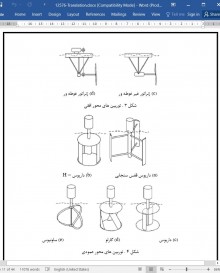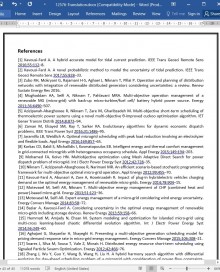
دانلود مقاله زمان بندی کوتاه مدت چند منظوره میکروگرید های مبتنی بر تجدیدپذیری
چکیده
کاربرد روزانه رو به افزایش تولید برق جزر و مدی، ویژگی های برجسته ی آن را به عنوان یک منبع تجدید پذیر اثبات می کند. به دلیل مسائل محیطی، انرژی جریان جزر و مدی، که هیچ انتشار گلخانه ای ندارد، توجه محققان بسیاری را در دهه گذشته به خود جلب کرده است. بعلاوه، پتانسیل خاص فناوری های جزر و مدی برای نفع اقتصادی در دوره های بلند مدت ضروری است. انرژی جزر و مدی می تواند مبتنی بر داده های کوتاه مدت پیش بینی شود، و بنابراین یک منبع تجدیدپذیر قابل اعتماد می باشد، که می تواند در سیستم های برق به کار رود. در این مقاله، بررسی های اثرات توربین جزرو مد جریان عملی در دریاچه ساروما در منطقه ی شرقی هاکایدو، ژاپن، که در یک میکروگرید (MG) واقعی قرار گرفته است، به منظور حل یک مساله ی بهینه سازی دو منظوره اقتصادی/ محیطی، در نظر گرفته می شود. برای این منظور، یک الگوریتم تغییر یافته بهینه سازی جفت گیری پرنده ( MMOBMO ) چند منظوره تکاملی هوشمند ارائه می شود. بعلاوه، یک مدل اقتصادی کامل از لوازم ذخیه سازی، در این مساله در نظر گرفته می شود. نتایج، کارآیی الگوریتم پیشنهادی را در اهداف مطلوب اقتصادی/ محیطی را نشان می دهد. کارآیی رویکرد ارائه شده با مقایسه ی با BMO و PSO اصلی در یک MG عملی ارزیابی می شود.
1 . مقدمه
جزر و مد، یا به عبارت دیگر، نوسانات آب اقیانوس، به دلیل اصول گرانش بین ماه، خورشید، و زمین رخ می دهد. بنابراین، انرژی جزر و مد می تواند به عنوان یک دسته از انرژی های تجدید پذیر در نظر گرفته شود. در مقایسه با دیگر انواع منابع تجدید پذیر از قبیل انرژی باد، خورشید، و جزر و مد، می تواند طبق دسته های داده های کوتاه مدت، بهتر پیش بینی شود [1]. با احتمال به دست آوردن دقیق پیش بینی جزر و مد، محققان می توانند به جریان های جزر و مد تکیه کنند تا به مدت های طولانی برق تولید کنند [2]. از نقطه نظر انتشار، انرژی جزر و مد هیچ گونه آلودگی هوا، آب یا دمایی ایجاد نمی کند. با این حال، از نقطه نظر اقتصادی، گرچه بررسی اولیه ی نیروی جزر و مد نسبتا بالا است، مزایایی بعدی آن قابل توجه می باشند. فناوری های انرژی جزر و مد به سه دسته ی اصلی تقسیم می شوند: محدوده ی جزر و مد، توربین های جریان جزر و مد (TST)، و فناوری های ترکیبی [2].
مقادیر نامناسب سوخت های فسیلی، به همراه مساله گرم شدن دنیا، ظهور منابع انرژی تجدید پذیر (RES) را افزایش می دهد، که از بین آن ها توربین ها طبق مزایای فوق الذکر، اهمیت بالایی دارند. RES های مختلفی از قبیل ژنراتور های بادی، فوتو ولتاییک (PV) و جزر و مدی در میکروگرید ها، به منظور بهره برداری از آن ها به عنوان ژنراتور به کار می روند، تا قابلیت اطمینان سیستم برق افزایش یافته و کارایی بهتری به دست آید [3]. به منظور تامین بار، با وجود این که سطوح کمینه ی هزینه و نشر تحت شرایط خاص برآورده می شوند، برق رسانی محیطی/ اقتصادی MG ها، باید به عنوان یک مساله چند منظوره در نظر گرفته شود.
6 . نتیجه گیری
اثرات پیاده سازی عملی توربین جریان جزر و مدی (TST) میکروگرید سبز دریاچه ی ساروما در یک MG نوعی در این مقاله بررسی شده اند. مدیریت بهینه ی انرژی سیستم با استفاده از الگوریتم MMOBMO بررسی شد، در حالی که یک مدل محیطی / اقتصادی نوین برای TST، به همراه مدل اقتصادی کاملی برای لوازم ذخیره سازی، ارائه شدند. مشاهده شد که از آن جایی که مولد های PV و جزر و مدی مکمل می باشند، یک MG حاوی این دو مولد، در تامین پایدار بار مناسب تر می باشد. به منظور نشان دادن کارایی موثر الگوریتم ارائه شده، دو حالت مختلف مورد مطالعه قرار گرفتند. بعلاوه، حالت های روشن/ خاموش DG های برق رسان، در نظر گرفته شدند. در نتیجه برتری الگوریتم در حل مسائل صحیح-مختلط، در مقایسه با PSO و BMO اصلی، ارزیابی شد. علاوه بر مزایای اقتصادی، از آنجایی که انرژی جزر و مد بسیار قابل پیش بینی می باشد، توصیه می شود که در نواحی با پتانسیل بالای مهار انرژی جزر و مد، دیگر واحد های تجدید پذیر با مولد های جزر و مدی جایگزین شوند. مطالعات آتی می توانند شامل موارد زیر باشند:
1 ) در نظر گرفتن عدم قطعیت منابع تجدید پذیر از قبیل مولد های PV و جزر و مدی، و حل مساله ی احتمالی مدیریت انرژی MG.
2 . بررسی پاسخ به تقاضا و اثرات خودروهای برق همراه با اجزای دیگر شبکه ها هوشمند آتی در مدیریت انرژی MG مورد نظر.
3 . بررسی موضوع قابلیت اطمینان به عنوان یک تابع هدف در عملکرد بهینه ی MG.
Abstract
Daily increasing use of tidal power generation proves its outstanding features as a renewable source. Due to environmental concerns, tidal current energy which has no greenhouse emission attracted researchers’ attention in the last decade. Additionally, the significant potential of tidal technologies to economically benefit the utility in long-term periods is substantial. Tidal energy can be highly forecasted based on short-time given data and hence it will be a reliable renewable resource which can be fitted into power systems. In this paper, investigations of effects of a practical stream tidal turbine in Lake Saroma in the eastern area of Hokkaido, Japan, allocated in a real microgrid (MG), is considered in order to solve an environmental/economic bi-objective optimization problem. For this purpose, an intelligent evolutionary multi-objective modified bird mating optimizer (MMOBMO) algorithm is proposed. Additionally, a detailed economic model of storage devices is considered in the problem. Results show the efficiency of the suggested algorithm in satisfying economic/environmental objectives. The effectiveness of the proposed approach is validated by making comparison with original BMO and PSO on a practical MG.
1. Introduction
Tides, i.e. ocean water oscillations, occur due to gravity principles among the moon, the sun and the earth. Therefore, tidal energy can be assumed as a class of renewable energies. In comparison with other kinds of renewable resources such as wind and solar, tidal energy can be claimed to be better predictable according to the short time data categories [1]. With the possibility of acquiring accurate tidal prediction, researchers can rely confidently on tidal currents to produce electricity for long term periods [2]. From the emission standpoint, tidal energy does not result in any air, water or thermal pollution. However, from the economic standpoint, although the primary investment of tidal power is approximately high, its subsequent benefits are highly considerable. Tidal energy technologies are categorized into three major groups, namely tidal range, tidal current or tidal stream turbines (TST) and hybrid technologies [2].
Inadequate amounts of fossil fuel along with global warming concerns give rise to the appearance of renewable energy sources (RES) among which tidal turbines are of great importance according to the above mentioned advantages. Different RESs including tidal, photovoltaic (PV) and wind generators beside energy storage systems are used in microgrids (MGs) in order to take their benefits as power generators to increase the reliability of the power system and to yield better performance [3]. In order to supply the load while minimum levels of cost and emission are satisfied under considered constraints, the economic⧹environmental dispatch of MGs shall be taken into account as a multi-objective problem.
6. Conclusions
The effects of implementing the practical tidal stream turbine (TST) of Lake Saroma green microgrid (SLMG) in a typical MG were dealt with in this paper. The optimal energy management of the system was investigated using the proposed MMOBMO algorithm, while a new economic/environmental model for the practical TST along with a detailed economic model for storage devices were presented. It was observed that since PV and tidal generators are complementary, an MG consisting of these two generators is more proper in sustainably supplying load. In order to demonstrate the effective performance of the proposed algorithm, two different cases were studied. Moreover, the ON/OFF states of dispatchable DGs were taken into account. Consequently, the superiority of the algorithm in dealing with mixedinteger problems in comparison with PSO and the original BMO was verified. In addition to economic advantages, since tidal energy is well predictable, it was suggested that in regions with high potential of harnessing tidal energies, other renewable units shall be replaced by tidal generators. Future works can include the following:
(i) Considering the uncertainties of renewable resources including tidal and PV generators and solving the probabilistic MG’s energy management.
(ii) Investigating demand response and electric vehicles’ effects along with other elements of the future smart grid in the considered MG’s energy management.
(iii) Inspecting reliability subject as an objective function in the MG’s optimal operation.
چکیده
1 . مقدمه
2 . مدل سازی اقتصادی/ محیطی مولدهای جریان جزر و مدی
2 . 1 فناوری های انرژی جزر و مدی
2 . 2 مدل خروجی توان TST
3 . 2 . ملاحظات محیطی
4 . 2 . مدل سازی اقتصادی
3 . شکل گیری (فرموله سازی) مساله
1 . 3. کاهش انتشار و هزینه
2 . 3 . شرایط مرزی
4 . کاربرد روش ارائه شده
1 . 4 . بهینه سازی چند منظوره
2 . 4 . الگوریتم BMO تغییر یافته
2 .1 . 4 . الگوریتم بهینه سازی جفت گیری پرنده
2 . 2 . 4 . BMO چند منظوره (MOBMO)
3. 2 . 4 . الگوریتم BMO چند منظوره تغییر یافته (MMOBMO)
3 .4 . کاربرد روش ارائه شده
5 . نتایج شبیه سازی
1 . 5 . سناریوی اول
2 . 5 . سناریوی دوم
6 . نتیجه گیری
منابع
ABSTRACT
1. Introduction
2. Economic/environmental modelling of tidal stream generators
2.1. Tidal energy technologies
2.2. Power output model of TST
2.3. Environmental considerations
2.4. Economic modelling
3. Problem formulation
3.1. Cost and emission minimization
3.2. Constraints
4. Application of the proposed methodology
4.1. Multi-objective optimization
4.2. Modified BMO algorithm
4.2.1. Bird mating optimizer algorithm
4.2.2. Multi-objective BMO (MOBMO)
4.2.3. Modified multi-objective BMO algorithm (MMOBMO)
4.3. Application of the proposed methodology
5. Simulation results
5.1. First scenario
5.2. Second scenario
6. Conclusions
References
- اصل مقاله انگلیسی با فرمت ورد (word) با قابلیت ویرایش
- ترجمه فارسی مقاله با فرمت ورد (word) با قابلیت ویرایش، بدون آرم سایت ای ترجمه
- ترجمه فارسی مقاله با فرمت pdf، بدون آرم سایت ای ترجمه



